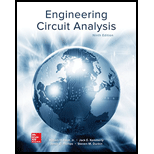
(a)
The value of L−1{G(s)}.
(a)
Answer to Problem 33E
The value of L−1{G(s)} is 24te−4tu(t)+6e−4tu(t)−6e−2tu(t)_.
Explanation of Solution
Given data:
The function is given as,
G(s)=3s(s2+2)2(s+2)
Calculation:
The function is simplified as,
G(s)=3s(s2+2)2(s+2)=12s(s+4)2(s+2) (1)
Apply the partial fraction on the above expression.
12s(s+4)2(s+2)=A(s+4)2+B(s+4)+C(s+2) (2)
The equation is written as,
12s=A(s+2)+B(s+4)(s+2)+C(s+4)2 (3)
Substitute −2 for s in equation (3).
−24=A(0)+B(0)+C(−2+4)2−24=4CC=−6
Substitute −4 for s in equation (3).
−48=A(−4+2)+B(0)+C(0)−48=−2AA=24
The simplification of equation (3) is written as,
12s=(B+C)s2+(A+6B+8C)s+(2A+8B+16C) (4)
Equate the coefficient of s2 of equation (4).
B+C=0
Substitute −6 for C in the above expression.
B−6=0B=6
Substitute 24 for A, 6 for B and −6 for C in equation (2).
12s(s+4)2(s+2)=24(s+4)2+6(s+4)+−6(s+2)=24(s+4)2+6(s+4)−6(s+2)
Substitute 24(s+4)2+6(s+4)−6(s+2) for 12s(s+4)2(s+2) in equation (1).
G(s)=24(s+4)2+6(s+4)−6(s+2)
The Laplace transform of e−atu(t) is written as,
L[e−atu(t)]=1s+a
The Laplace transform of te−atu(t) is written as,
L[te−atu(t)]=1(s+a)2
The properties for Laplace transform are written as,
L{f1(t)+f2(t)}=L{f1(t)}+L{f2(t)}
L−1{kF(s)}=kL−1{F(s)}
The inverse Laplace of the given function is written as,
g(t)=L−1{G(s)} (5)
Substitute 24(s+4)2+6(s+4)−6(s+2) for G(s) in equation (5).
g(t)=L−1{24(s+4)2+6(s+4)−6(s+2)}=24L−1{1(s+4)2}+6L−1{1(s+4)}−6L−1{1(s+2)}=24te−4tu(t)+6e−4tu(t)−6e−2tu(t)
Conclusion:
Therefore, the value of L−1{G(s)} is 24te−4tu(t)+6e−4tu(t)−6e−2tu(t)_.
(b)
The value of L−1{G(s)}.
(b)
Answer to Problem 33E
The value of L−1{G(s)} is 3δ(t)+3.75te−5tu(t)−2.625e−5tu(t)+2.625e−7tu(t)_.
Explanation of Solution
Given data:
The function is given as,
G(s)=3−3s(2s2+24s+70)(s+5)
Calculation:
The function is simplified as,
G(s)=3−3s(2s2+24s+70)(s+5)=3−3s2(s2+12s+35)(s+5)=3−1.5s(s+5)(s+7)(s+5)=3−1.5s(s+7)(s+5)2 (6)
Apply the partial fraction on the above expression.
1.5s(s+7)(s+5)2=A(s+5)2+B(s+5)+C(s+7) (7)
The equation is written as,
1.5s=A(s+7)+B(s+7)(s+5)+C(s+5)2 (8)
Substitute −7 for s in equation (8).
−10.5=A(0)+B(0)+C(−7+5)2−10.5=4CC=−2.625
Substitute −5 for s in equation (8).
−7.5=A(−5+7)+B(0)+C(0)−7.5=2AA=−3.75
The simplification of equation (8) is written as,
1.5s=(B+C)s2+(A+12B+10C)s+(7A+35B+25C) (9)
Equate the coefficient of s2 of equation (4).
B+C=0
Substitute −2.625 for C in the above expression.
B−2.625=0B=2.625
Substitute −3.75 for A, 2.625 for B and −2.625 for C in equation (7).
1.5s(s+7)(s+5)2=−3.75(s+5)2+2.625(s+5)+−2.625(s+7)=−3.75(s+5)2+2.625(s+5)−2.625(s+7)
Substitute −3.75(s+5)2+2.625(s+5)−2.625(s+7) for 1.5s(s+7)(s+5)2 in equation (6).
G(s)=3−[−3.75(s+5)2+2.625(s+5)−2.625(s+7)]=3+3.75(s+5)2−2.625(s+5)+2.625(s+7)
The Laplace transform of δ(t) is written as,
L[δ(t)]=1
Substitute 3+3.75(s+5)2−2.625(s+5)+2.625(s+7) for G(s) in equation (5).
g(t)=L−1{3+3.75(s+5)2−2.625(s+5)+2.625(s+7)}=3L−1{1}+3.75L−1{1(s+5)2}−2.625L−1{1(s+5)}+2.625L−1{1(s+7)}=3δ(t)+3.75te−5tu(t)−2.625e−5tu(t)+2.625e−7tu(t)
Conclusion:
Therefore, the value of L−1{G(s)} is 3δ(t)+3.75te−5tu(t)−2.625e−5tu(t)+2.625e−7tu(t)_.
(c)
The value of L−1{G(s)}.
(c)
Answer to Problem 33E
The value of L−1{G(s)} is 2δ(t)−e−100tu(t)+cos(10t)u(t)_.
Explanation of Solution
Given data:
The function is given as,
G(s)=2−1(s+100)+1s2+100
Calculation:
The function is simplified as,
G(s)=2−1(s+100)+1s2+100=2−1(s+100)+1s2+102
The Laplace transform of cosωtu(t) is written as,
L[cosωtu(t)]=1s2+ω2
Substitute 2−1(s+100)+1s2+102 for G(s) in equation (5).
g(t)=L−1{2−1(s+100)+1s2+102}=2L−1{1}−L−1{1(s+100)}+L−1{1s2+102}=2δ(t)−e−100tu(t)+cos(10t)u(t)
Conclusion:
Therefore, the value of L−1{G(s)} is 2δ(t)−e−100tu(t)+cos(10t)u(t)_.
(d)
The value of L−1{G(s)}.
(d)
Answer to Problem 33E
The value of L−1{G(s)} is tu(2t)_.
Explanation of Solution
Given data:
The function is given as,
G(s)=L[tu(2t)]
Calculation:
Substitute L[tu(2t)] for G(s) in equation (5).
g(t)=L−1{L[tu(2t)]}=tu(2t)
Conclusion:
Therefore, the value of L−1{G(s)} is tu(2t)_.
Want to see more full solutions like this?
Chapter 14 Solutions
ENGINEERING CIRCUIT...(LL)>CUSTOM PKG.<
- Find the Thevenin Equivalent Circuit of the circuit below and the current through R_L , show all steps;arrow_forwardFind the Norton Equivalent of the below and the voltage across R_L, show all steps;arrow_forwardUse Mesh Analysis to find the current through the laod resistor R_L. Show all steps;arrow_forward
- Find Thevenin Equivalent of the circuit below and the current through the load resistor R_L. Show all steps;arrow_forwardIf = 5000 A actual time IDMT ---R,, Reand R3 The Tsm relays R, and R3 Draw The characteistic relays time margin between Tsm = 0.5 RCT=500/1 CS-125% TSM = 2 TSM = 0.2 and -0.6 R2 CTS = 500/1 Cs=100% Tsm=0.4 R3 CTS = 400/1 Cs=125% TSM = 2arrow_forwardLet X and Y be random variables having joint density function 01.5). (c) p(x) and p(y).arrow_forward
- The joint density function of two continuous random variables X and Y is: p(x, y) = {cxy 0 < x < 4,1 < y < 5 0 otherwise Find (i) the constant c (ii)P(1arrow_forwardBelow is a rough schematic of the lighting system for a streetcar powered by a 120 VDC supply. How can I arrange the wires inside the trolley for the interior lights (1-16), headlights (19-20), doors (21-24), and platform lights (17-18), ensuring that each has its own switch? Does the electrical system require additional safety components? What type of cable can be used for wiring these lights?arrow_forward12.8 Obtain the inverse Laplace transform of each of the fol- lowing functions by first applying the partial-fraction-expansion method. (a) Fi(s) 6 = (s+2)(s+4) (b) F2(s) = (c) F3(s) = 4 (s+1)(s+2)2 3s3 +36s2+131s+144 s(s+4)(s²+6s+9) 2s²+4s-10 (d) F4(s) = (s+6)(s+2)²arrow_forward
- 12.4 Determine the Laplace transform of each of the followingfunctions by applying the properties given in the Tables (a) f1(t) = 4te−2t u(t)(b) f2(t) = 10cos(12t +60◦) u(t)*(c) f3(t) = 12e−3(t−4) u(t −4)(d) f4(t) = 30(e−3t +e3t ) u(t)(e) f5(t) = 16e−2t cos4t u(t)(f) f6(t) = 20te−2t sin4t u(t)arrow_forward8. Obtain the inverse Laplace transform of each of the followingfunctions by first applying the partial-fraction-expansionmethod.(a) F1(s) =6(s+2)(s+4)(b) F2(s) =4(s+1)(s+2)2(c) F3(s) =3s3 +36s2 +131s+144s(s+4)(s2 +6s+9)(d) F4(s) =2s2 +4s−10(s+6)(s+2)2arrow_forward12.12 In the circuit of Fig. P12.12(a), is(t) is given by the waveform shown in Fig. P12.12(b). Determine iL (t) for t≥ 0, given that R₁ = R₂ = 2 2 and L = 4 H. is() R₁ R2: (a) Circuit is(t) 8A- 8e-21 elle (b) is(t) Figure P12.12 Circuit and waveform for Problem 12.12. iLarrow_forward
 Introductory Circuit Analysis (13th Edition)Electrical EngineeringISBN:9780133923605Author:Robert L. BoylestadPublisher:PEARSON
Introductory Circuit Analysis (13th Edition)Electrical EngineeringISBN:9780133923605Author:Robert L. BoylestadPublisher:PEARSON Delmar's Standard Textbook Of ElectricityElectrical EngineeringISBN:9781337900348Author:Stephen L. HermanPublisher:Cengage Learning
Delmar's Standard Textbook Of ElectricityElectrical EngineeringISBN:9781337900348Author:Stephen L. HermanPublisher:Cengage Learning Programmable Logic ControllersElectrical EngineeringISBN:9780073373843Author:Frank D. PetruzellaPublisher:McGraw-Hill Education
Programmable Logic ControllersElectrical EngineeringISBN:9780073373843Author:Frank D. PetruzellaPublisher:McGraw-Hill Education Fundamentals of Electric CircuitsElectrical EngineeringISBN:9780078028229Author:Charles K Alexander, Matthew SadikuPublisher:McGraw-Hill Education
Fundamentals of Electric CircuitsElectrical EngineeringISBN:9780078028229Author:Charles K Alexander, Matthew SadikuPublisher:McGraw-Hill Education Electric Circuits. (11th Edition)Electrical EngineeringISBN:9780134746968Author:James W. Nilsson, Susan RiedelPublisher:PEARSON
Electric Circuits. (11th Edition)Electrical EngineeringISBN:9780134746968Author:James W. Nilsson, Susan RiedelPublisher:PEARSON Engineering ElectromagneticsElectrical EngineeringISBN:9780078028151Author:Hayt, William H. (william Hart), Jr, BUCK, John A.Publisher:Mcgraw-hill Education,
Engineering ElectromagneticsElectrical EngineeringISBN:9780078028151Author:Hayt, William H. (william Hart), Jr, BUCK, John A.Publisher:Mcgraw-hill Education,





